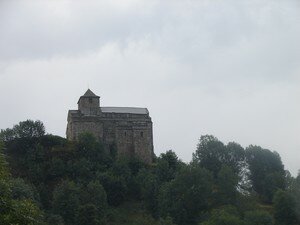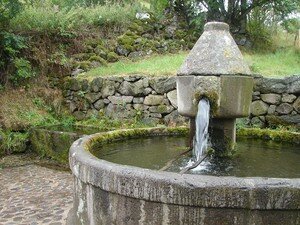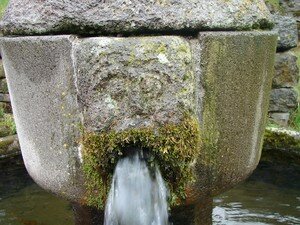Bredons
 Michel
Rouche, professor of medieval history in the Sorbonne, held a
conference on the topic: “15 centuries of history of Bredons”.
Michel
Rouche, professor of medieval history in the Sorbonne, held a
conference on the topic: “15 centuries of history of Bredons”.
A marked out history of internal fights, competitions for the division of the capacity and the privileges.
Thus it specified that the name of Bredons comes from the Celtic word dunum, which means: raised site, fortress.
The first inhabitants were installed on easily fortifiable hills, which explains a presence
human on the site of Bredons as of the Neolithic era.
A
monastery will be founded there with the XI° the community will never
exceed 6 monks. The territory of Bredons depended at the XI ième
century on the goods on the family on Henry, noble family having of
vast fields between Murat and Saint-Flour.
The construction of the priory
Saint-Pierre-Saint-Paul de Bredons begins in 1050, under the impulse of
Durand of Henry, converted monk Benedictine and originating in an
important family of Murat. It will become, in 1057, abbot of Moissac.
Built
in 1075, the church prieurale is devoted in 1095 by the bishop of
Clermont, at the time of the visit of the pope Urbain II. It is built
with the site of the old Saint-Timothée vault and the Holy Cross, and
is dedicated to the saints Pierre and Paul.
In 1284, by a contract between the Prior of Bredons and Bailly of the Mounts of Auvergne under the terms of which is shared legal and financial sovereignty, King St Louis made raise on the rock of Bredons, at the climax, the tower of Beccoire. There remain nothing of these constructions. This tower which dominated the priory of Bredons with range of voice sometimes undoubtedly appeared to the Prior like a symbol encumbering of the laic capacity.
About 1350, in high Auvergne, bands of plunderers known under the
name of “English Bands appeared”. Many churches were burnt. The area
left at that time a long period of misery where the simple lack of
maintenance had been able to precipitate the ruin of constructions. It
is perhaps in these times that the vaults disappear from the nave of
the church.
In 1384, the bishop of Saint-flour authorizes the chapter of Murat
to build a church indicating that the vicinity of the English and the
war without mercy that were made the applicants with vicomté of Murat
prevented the inhabitants of the city from going to fill their
religious duties with Bredons. It was built in two years. This decision
was the object of quarrels between the Prior of Bredons and the chapter
of Murat
About 1704, the cure of Murat is given to the priory.
For this time, the city has had as a parish church that of the abbey.
The relations between Murat and Bredons will not cease being degraded,
requiring the intervention of the pope sometimes. Thus Urbain II
(1088-1099), which preached the first crusade, must slice leprieuré
lawsuits concerning.
The canons of the collegial Saint Martin's day
with Murat dispute the authority of the priory of Bredons.
Disagreements appear at the beginning of the XIV° between the Viscount
of Murat and the priory of Bredons. This community enters in conflict
with the monks of collegial Notre-Dame de Murat.
At the end of the XV ièmè century, great repairs were undertaken
with the church of Bredons by the prior Jean II of Prez de Montpezat.
Between 1517 and 1542, the new Prior Antoine d' Auriol, enlightened
amateur at the time of the Italian influence equipped the church with a
whole of stalls and woodworks of great quality which one can consider
it regrettable that a part only reached us.
Antoine d' Anglade,
last regular Prior of Bredons undertaken of important work of
restoration of the south-western part of the church where its blazon is
visible with the reverse of the Western frontage. Between 1664 and
1757, the spirit of the reform transforms the interior decoration of
Bredons, but the important retables which one can admire there today
were especially due to the priests and marguilliers: the Priors of then
give up readily the administration of temporal between the hands of a
manager and reside less and less on the spot.
A
law of the national assembly having ordered the sale of the national
goods before September 15, 1790, the municipality of Murat put the
Priory of Bredons on sale. No purchaser presented himself. The
population, fleeing the sworn in priests, came to follow in Bredons the
offices of refractories. In 1791, the municipality of Murat closed the
church of Bredons. Rather violent riots were followed from there.
In
1795 the district of the “Fontillou” with Murat having burned, the town
council authorized the disaster victims to take stones of the buildings
of the Priory to rebuild their houses. At the same time the bell-tower
was demolished and rebuilt in its current state.
In 1840 the church
of Bredons was classified Historic building and one repaired the
disorders which in masonries the demolition of the buildings of the
Priory had caused. (according to Michel Jantzen,
Architect in chief of the M.H.)
It is astonishing that in the history of the priory, nobody speaks about the black virgin, marvellous Romance statue of majesty, stolen in 1953. One granted an Eastern relationship thanks to Louis saint to him who would have made gift with the church of it. (definitely, its bags were to be quite heavy on its return).
Celà also explains why, on the other side of the valley, the black virgin of Murat, although posterior in date, makes a point of being attached to Saint Louis. (Jacques Bonvin)
Before arriving at the priory, in the
village of Bredons, a splendid fountain and its various basins make me
think of the druidism. Especially when one sees the figure from where
water runs…
Not far, a stone posed with very the ground recalls a menhir lying.
The landscape neighbourhood is splendid, and the volcanic deck being used as a basis vibrates very extremely.

/https%3A%2F%2Fprofilepics.canalblog.com%2Fprofilepics%2F1%2F1%2F116167.jpg)
/https%3A%2F%2Fstorage.canalblog.com%2F49%2F16%2F312499%2F14620054_o.jpg)
/https%3A%2F%2Fstorage.canalblog.com%2F53%2F18%2F312499%2F14151229_o.jpg)
/https%3A%2F%2Fstorage.canalblog.com%2F07%2F05%2F312499%2F14149867_o.jpg)
/https%3A%2F%2Fstorage.canalblog.com%2F11%2F35%2F312499%2F14149307_o.jpg)
/https%3A%2F%2Fstorage.canalblog.com%2F90%2F14%2F312499%2F14125247_o.jpg)





/https%3A%2F%2Fstorage.canalblog.com%2F12%2F98%2F137895%2F6624411_p.jpg)
/https%3A%2F%2Fstorage.canalblog.com%2F34%2F82%2F137895%2F27207854_p.jpg)
/https%3A%2F%2Fstorage.canalblog.com%2F32%2F37%2F137895%2F15872299_p.jpg)
/https%3A%2F%2Fstorage.canalblog.com%2F37%2F81%2F137895%2F15879822_p.jpg)